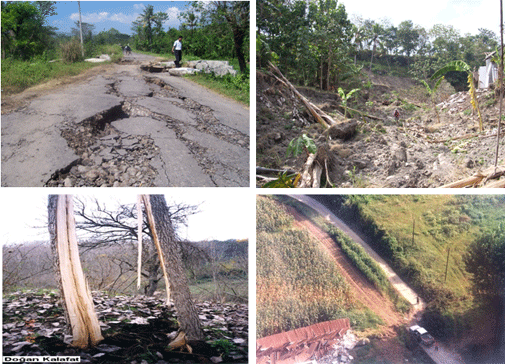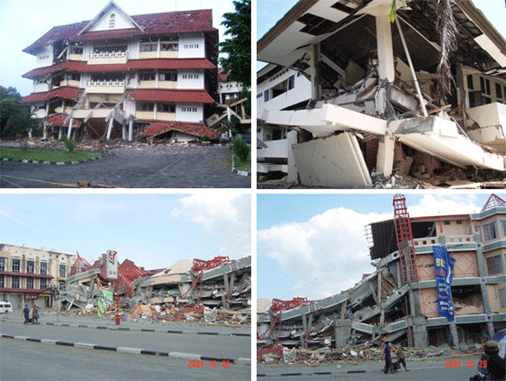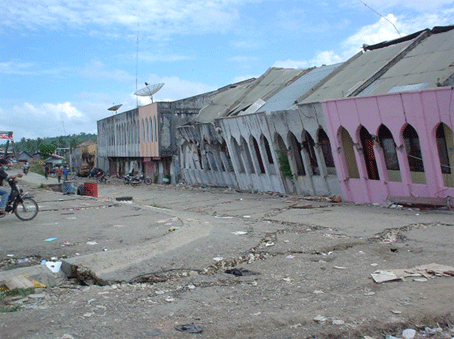Read in Bahasa Indonesia
What is an earthquake?
Earthquake is a natural phenomenaa producing ground shaking by a sudden energy release inside the earth's crust. When the accumulated elastic strain energy is efficiently large enough to exceed the friction resistance of tectonic plate interfaces, the slip then occurrs and is followed by dissipation of seismic waves causing an earthquake.
Earthquake Parameters
 Origin Time (OT)
Origin Time (OT)
 Episenter
Episenter
 Depth
Depth
 Magnitude
Magnitude
Earthquake Characteristics
 Occurs rapidly
Occurs rapidly
 On specific location, normally near the plate boundaries
On specific location, normally near the plate boundaries
 May induce disaster
May induce disaster
 Recurrance potential
Recurrance potential
 Earthquake prediction - for the future is challenge
Earthquake prediction - for the future is challenge
 Earthquake mitigation to reduce the impact
Earthquake mitigation to reduce the impact
Why do earthquakes happen ?
Tectonic Plate

It refers back to the theory of plate tectonics that the earth's surface consist of a number of large intact block, named as plates. The plates are defined as the rigid segment of earth's crust which ride on the asthenosphere. Being weaker, hotter and less solid than the plates, asthenosphere initiates the plates to move with respect to each other at one of three types of plate boundaries: convergent or collisional boundaries; divergent boundaries or spreading centers and conservative transform boundaries.

The movement of the plates is set off due to requirement of thermomechanical equilibrium of the earth's materials. The upper portion of the mantle is in contact with the relatively cool crust while the lower portion is in contact with the hot outer core. The outer core is considered extremely hot so that it always is formed in unsolid material and cause the lower portion of the mantle to move by the redistribution of the heat, called as convection.
When two plates interact within a fault, they can move toward each other, apart from each other, or pass each other. Generally, the plates move so slowly causing human unable to experience the movement. However, by using today's instrumentation, the movement of the plates can be recorded as 0 cm to 15cm in a year.
It is usually found that the plate movement may stuck and undergo interlocking time by time. This situation will initiate energy accumulation in earth's crust until the accumulated energy is greater than the friction resistance of the plates. The accumulated energy will be then suddenly released in form of seismic waves and known as earthquake.
Deformation of the plates mainly occurs within the plate boundaries. Hence it is expected that the location of earthquakes is concentrated mostly near the plate boundaries.
World Earthquake Zone

Indonesia is considered as one of the zone prone to earthquake. This situation comes up due to the position of Indonesia in boundary of 3 major tectonic plates : Indian-Australian, Eurasian and Pacific. The Indian-Australian plate have a tendency to move to the north causing subduction zone below the Eurasian plates. Meanwhile the Pacific plate move relatively to the west.
The plate boundaries are found under the sea. Hence, any large and shallow earthquake generated from this zone may potential to generate tsunami. These situations therefore classify Indonesia into one of the most prone region to tsunami. Learning from many earthquakes and tsunamis such as Aceh and Pangandaran, it is then required to have a comprehensive and integrated mitigation effort that shall be implemented by both government and the public.
It is recognized that there is a time difference between the time when earthquake occur and the time when tsunami is generated. This condition is useful to deliver the early warning to the public as part of the mitigation effort and BMKG has showed its commitment in this effort by establishing the Indonesian Tsunami Early Warning Systems (Ina-TEWS).
Impact of Earthquake
 Ground shaking
Ground shaking
 Liquifaction
Liquifaction
 Landslide
Landslide
 Tsunami
Tsunami
 Secondary effect (short circuit, gas leak that may induce fire)
Secondary effect (short circuit, gas leak that may induce fire)
Factors that trigger damages during an earthquake
 Magnitude of Earthquake
Magnitude of Earthquake
 Depth of Hypocenter
Depth of Hypocenter
 Epicenter Distance
Epicenter Distance
 Duration
Duration
 Local Site Condition
Local Site Condition
 Building Condition
Building Condition
Impact of an earthquake on the environment

Impact of an earthquake on buildings

Impact of liquefaction on buildings

Secondary effect of earthquakes - fire

Read in Bahasa Indonesia

